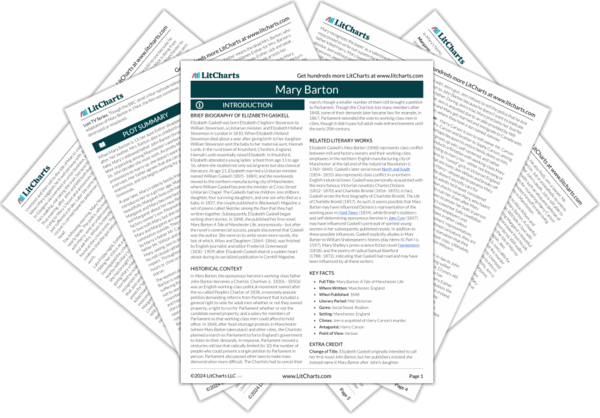In Mary Barton, class conflict between capitalist employers and the workers they employ does not stem from economic principles or divergent class interests. Rather, the novel argues that employers’ and workers’ interests are intimately bound together—but that employers nevertheless alienate and embitter workers by failing to communicate appropriately with them.
Set in the first half of the 19th century in the English manufacturing town of Manchester, Mary Barton focuses on the conditions and effects of factory work during an economic downturn. The factory owners fear that clients will only buy from the factories that produce goods at the lowest cost. Therefore, the Manchester employers offer their workers extremely low wages in hopes of producing the goods at the lowest cost; according to their reasoning, this strategy will allow both employers and workers to make at least some money—whereas if another factory in Europe produces the order at lower cost, no one in Manchester will earn anything. At least in the employers’ view, then, it is in both the workers’ and the employers’ interest for the workers to temporarily accept lowered wages. Yet the employers never communicate to the workers the potential competition from European factories or the reasoning behind the lowered wages. Understandably, the workers see the offer of extremely low wages as exploitative, and so they go on strike. Even during the strike, the employers refuse to explain their original reasoning, believing that workers should simply obey them. This arrogant failure to communicate leads to ongoing striking and, eventually, a murder. Thus, Mary Barton attributes class conflict between employers and workers not to any kind of inherent tension or single economic principle, but to employers’ personal failings: arrogance, stubbornness, short-sightedness, and failures of compassion.
Employers vs. Workers ThemeTracker

Employers vs. Workers Quotes in Mary Barton
So with this consciousness she had early determined that her beauty should make her a lady; the rank she coveted the more for her father’s abuse; the rank at which she firmly believed her lost Aunt Esther had arrived.
The weekly drain of wages given for labour, useless in the present state of the market, was stopped. The partners had more leisure than they had known for years[.]
“Don ye think He’s the masters’ Father, too? I’d be loth to have ‘em for brothers.”
“Eh, John! donna talk so; sure there’s many and many a master as good or better nor us.”
“If you think so, tell me this. How comes it they’re rich, and we’re poor? I’d like to know that. Han they done as they’d be done by for us?”
For, be it remembered, she had the innocence, or the ignorance, to believe his intentions honourable; and he, feeling that at any price he must have her, only that he would obtain her as cheaply as he could, had never undeceived her[.]
So class distrusted class, and their want of mutual confidence wrought sorrow to both. The masters would not be bullied, and compelled to reveal why they felt it wisest and best to offer only such low wages; they would not be made to tell that they were even sacrificing capital to obtain a decisive victory over the continental manufacturers. And the workmen sat silent and stern with folded hands, refusing to work for such pay.
While the men had stood grouped near the door, on their first entrance, Mr Harry Carson had taken out his silver pencil, and had drawn an admirable caricature of them—lank, ragged, dispirited and famine-stricken. Underneath he wrote a hasty quotation from the fat knight’s well-known speech in Henry IV. He passed it to one of his neighbours, who acknowledged the likeness instantly, and by him it was sent round to others, who all smiled and nodded their heads.
A number of pieces of paper (from the identical letter on which the caricature had been drawn that very morning) were torn up, and one was marked.
The eyes of John Barton grew dim with tears. Rich and poor, masters and men, were then brothers in the deep suffering of the heart; for was not this the very anguish he had felt for little Tom, in years so long gone by that they seemed like another life!
“You say our talk has done no good. I say it has. I see the view you take of things from the place where you stand.”
To those who have large capability of loving and suffering, united with great power of firm endurance, there comes a time in their woe when they are lifted out of the contemplation of their individual case into a searching inquiry into the nature of their calamity, and the remedy (if remedy there be) which may prevent its recurrence to others as well as themselves.











